Never miss another geomagnetic storm. Sign up for Space Weather Alerts and you'll receive a text message when magnetic storms erupt. Aurora tour guides and professional astronomers use this service. You can, too! | | |
CHANCE OF STORMS TODAY: NOAA forecasters say that minor G1-class geomagnetic storms are possible later today and tomorrow, Sept. 23-24, when a high-speed stream of solar wind is expected to hit Earth's magnetic field. The gaseous material is flowing from an equatorial hole in the sun's atmosphere. Aurora alerts: SMS Text.
MAGNETIC FILAMENT ERUPTION: Today (Sept 23rd around 13:30 UT), a large filament of magnetism near the sun's southwestern limb became unstable and erupted. NASA's Solar Dynamics Observatory recorded the blast:
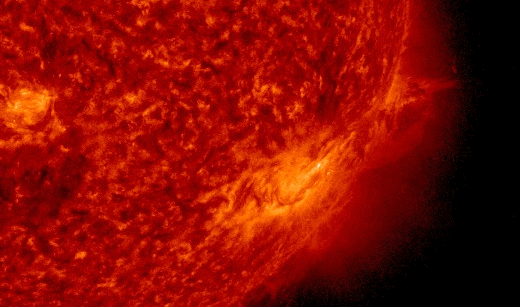
Shortly after the explosion, the US Air Force reported a Type II solar radio burst, a natural form of radio emission produced by shock waves moving through the sun's atmosphere. Characteristics of the burst suggest that a CME was being hurled into space at a speed of 820 km/s (1.8 million mph).
Will it hit Earth? Probably not. The explosion occured near the edge of the Earth strike zone. Fresh data from SOHO coronagraphs are required for confirmation. Stay tuned. Aurora alerts: SMS Text.
Realtime Space Weather Photo Gallery
Free: Spaceweather.com Newsletter
CHINA'S GROWING SPACE STATION: China's Tiangong space station is in the big leagues now. In the past year alone, it has more than doubled in size, and it is starting to rival its older cousin the International Space Station (ISS). On Sept. 22nd, astrophotographer Philip Smith watched Tiangong fly over his backyard in New York. "It was bright!" he says. "I created this composite photo to show how much it has grown."
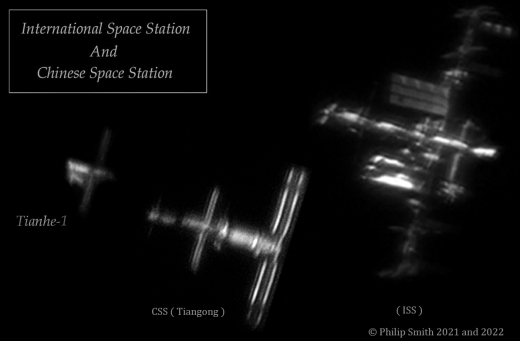
On the left is station's original core module, Tianhe-1, which Smith photographed in 2021. On the right is a recent photo of the International Space Station. Between the two is Tiangong as it appeared to Smith on Sept. 22nd.
"I scaled all of these images so they show the spacecraft as they would appear side-by-side at the same distance from my telescope," notes Smith.
With solar arrays, a robotic arm, multiple modules, and two spacecraft (Tianzhou 4 and Shenzhou 14) waiting at docking ports, Tiangong is starting to look a lot like the ISS. The ISS is still much larger, but China is catching up.
When it is completed in December 2023, Tiangong with be a Mir-class facility massing nearly 70 tons with living space for as many as 7 astronauts and even a Hubble-class telescope to view the cosmos.
Realtime Space Weather Photo Gallery
Free: Spaceweather.com Newsletter
A DRAGONFLY IN THE STRATOSPHERE: Are you looking for a far-out gift? Consider the Sterling Silver Space Dragonfly. This winged pendant has flown 113,451 feet above the Sierra Nevada mountains of California, hitching a ride onboard an Earth to Sky Calculus cosmic ray balloon:
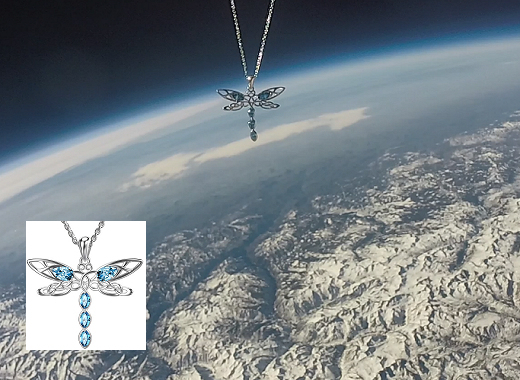
You can have it for $172.95. The dragonfly's heart is a Celtic love knot, and its wings are decorated with blue marquise crystals--all plated with 14k white gold. It's an exquisite ensemble for birthdays, anniversaries or any other romantic occasion.
The students are selling dragonfly pendants to support their cosmic ray ballooning program. Each one comes with a greeting card showing the pendant in flight and telling the story of its trip to the stratosphere and back again.
Far Out Gifts: Earth to Sky Store
All sales support hands-on STEM education
Realtime Aurora Photo Gallery
Free: Spaceweather.com Newsletter
Every night, a network of
NASA all-sky cameras scans the skies above the United States for meteoritic fireballs. Automated software maintained by NASA's Meteoroid Environment Office calculates their orbits, velocity, penetration depth in Earth's atmosphere and many other characteristics. Daily results are presented here on Spaceweather.com.
On Sep 23, 2022, the network reported 13 fireballs.
(13 sporadics)
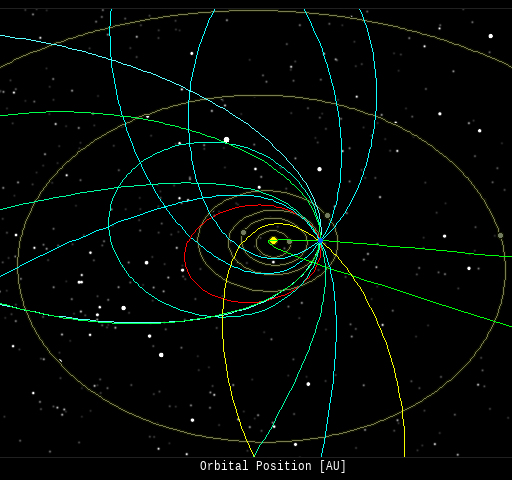
In this diagram of the inner solar system, all of the fireball orbits intersect at a single point--Earth. The orbits are color-coded by velocity, from slow (red) to fast (blue). [Larger image] [movies]
Potentially Hazardous Asteroids (
PHAs) are space rocks larger than approximately 100m that can come closer to Earth than 0.05 AU. None of the known PHAs is on a collision course with our planet, although astronomers are finding
new ones all the time.
On September 23, 2022 there were 2293 potentially hazardous asteroids.
 |
Recent & Upcoming Earth-asteroid encounters: | Asteroid | Date(UT) | Miss Distance | Velocity (km/s) | Diameter (m) |
| 2005 RX3 | 2022-Sep-18 | 12.4 LD | 17.5 | 110 |
| 2022 SB | 2022-Sep-18 | 3 LD | 17.9 | 11 |
| 2022 QB37 | 2022-Sep-18 | 17.2 LD | 9.2 | 59 |
| 2022 SS2 | 2022-Sep-18 | 2 LD | 7.3 | 13 |
| 2022 SA5 | 2022-Sep-18 | 2.7 LD | 22.8 | 23 |
| 2022 SF | 2022-Sep-19 | 14.6 LD | 16.8 | 25 |
| 2022 SF6 | 2022-Sep-19 | 3.1 LD | 12.4 | 11 |
| 2022 QJ50 | 2022-Sep-19 | 11 LD | 10.2 | 34 |
| 2022 SK4 | 2022-Sep-19 | 0 LD | 13 | 3 |
| 2022 SC1 | 2022-Sep-20 | 14.3 LD | 10.3 | 26 |
| 2022 SW1 | 2022-Sep-20 | 1.8 LD | 10.1 | 10 |
| 2022 SH | 2022-Sep-20 | 7.9 LD | 7.6 | 11 |
| 2022 SA1 | 2022-Sep-21 | 18.8 LD | 14.1 | 33 |
| 2022 SR2 | 2022-Sep-21 | 1.2 LD | 21.7 | 9 |
| 2022 SK1 | 2022-Sep-22 | 7.1 LD | 8.4 | 29 |
| 2022 SG3 | 2022-Sep-22 | 1.7 LD | 10.8 | 14 |
| 2022 ST1 | 2022-Sep-22 | 4 LD | 13.5 | 13 |
| 2022 SG | 2022-Sep-22 | 7.3 LD | 19.6 | 45 |
| 2022 QH8 | 2022-Sep-22 | 10.6 LD | 15.3 | 52 |
| 2022 SW3 | 2022-Sep-23 | 7.2 LD | 8.7 | 38 |
| 2022 QK36 | 2022-Sep-23 | 18.7 LD | 3.7 | 22 |
| 2022 SP | 2022-Sep-24 | 9.2 LD | 9.8 | 13 |
| 2022 SK | 2022-Sep-24 | 18.1 LD | 16.6 | 50 |
| 2022 RM | 2022-Sep-25 | 14.2 LD | 10 | 31 |
| 2022 SK6 | 2022-Sep-25 | 2.7 LD | 3.9 | 11 |
| 2022 SL1 | 2022-Sep-25 | 9.3 LD | 8 | 22 |
| 2022 SU1 | 2022-Sep-25 | 4 LD | 14 | 16 |
| 2022 SE6 | 2022-Sep-26 | 4 LD | 4.2 | 24 |
| 2022 SR4 | 2022-Sep-26 | 7.9 LD | 11 | 24 |
| 2022 SY4 | 2022-Sep-26 | 2.4 LD | 11.8 | 10 |
| 2022 SY2 | 2022-Sep-27 | 18.8 LD | 12.8 | 46 |
| 2022 SZ2 | 2022-Sep-27 | 1.5 LD | 3.6 | 10 |
| 2022 ST3 | 2022-Sep-27 | 18 LD | 17.5 | 32 |
| 2022 SD4 | 2022-Sep-27 | 10.7 LD | 9.8 | 18 |
| 2022 SP4 | 2022-Sep-27 | 15.6 LD | 13.2 | 52 |
| 2022 SO4 | 2022-Sep-28 | 13.6 LD | 11.5 | 27 |
| 2022 SP1 | 2022-Sep-28 | 19 LD | 4.6 | 20 |
| 2022 SZ | 2022-Sep-28 | 13.7 LD | 7.4 | 18 |
| 2022 SR1 | 2022-Sep-29 | 12.1 LD | 6 | 25 |
| 2016 HF2 | 2022-Sep-29 | 19.2 LD | 5.6 | 21 |
| 2018 ER1 | 2022-Oct-02 | 14.7 LD | 4 | 27 |
| 2018 VG | 2022-Oct-05 | 18.5 LD | 6.7 | 12 |
| 2021 TJ10 | 2022-Oct-06 | 19.6 LD | 8.1 | 6 |
| 2013 TJ6 | 2022-Oct-07 | 11.7 LD | 14.4 | 32 |
| 2022 RA5 | 2022-Oct-12 | 13.2 LD | 5.1 | 38 |
| 2022 SG6 | 2022-Oct-13 | 15.7 LD | 10.9 | 89 |
| 2013 SL20 | 2022-Oct-14 | 6.2 LD | 12.1 | 45 |
| 2020 TO2 | 2022-Oct-15 | 1.4 LD | 12.6 | 18 |
| 2020 BD | 2022-Oct-16 | 12.1 LD | 11.4 | 20 |
| 2022 QM6 | 2022-Oct-17 | 19.8 LD | 4.2 | 69 |
| 2022 RB5 | 2022-Oct-22 | 13.1 LD | 5.3 | 115 |
| 2005 AZ28 | 2022-Oct-24 | 11.5 LD | 5.4 | 48 |
| 2016 TH94 | 2022-Oct-25 | 19.1 LD | 13.5 | 43 |
| 2019 AN5 | 2022-Oct-27 | 20 LD | 6.8 | 215 |
| 2004 UT1 | 2022-Oct-29 | 4 LD | 6.3 | 17 |
| 2021 VH | 2022-Nov-01 | 5.9 LD | 5.3 | 4 |
| 2022 RM4 | 2022-Nov-01 | 6 LD | 23.5 | 443 |
| 2020 WD | 2022-Nov-08 | 3 LD | 6 | 8 |
| 2019 XS | 2022-Nov-10 | 16.7 LD | 11.9 | 60 |
| 2019 VL5 | 2022-Nov-15 | 8.5 LD | 8.1 | 24 |
| 2018 WH | 2022-Nov-16 | 2.5 LD | 7.7 | 4 |
| 2019 OR1 | 2022-Nov-21 | 18.1 LD | 13.4 | 246 |
Notes: LD means "Lunar Distance." 1 LD = 384,401 km, the distance between Earth and the Moon. 1 LD also equals 0.00256 AU. | | Cosmic Rays in the Atmosphere |
SPACE WEATHER BALLOON DATA: Almost once a week, Spaceweather.com and the students of Earth to Sky Calculus fly space weather balloons to the stratosphere over California. These balloons are equipped with sensors that detect secondary cosmic rays, a form of radiation from space that can penetrate all the way down to Earth's surface. Our monitoring program has been underway without interruption for 7 years, resulting in a unique dataset of in situ atmospheric measurements.
Latest results (July 2022): Atmospheric radiation is decreasing in 2022. Our latest measurements in July 2022 registered a 6-year low:
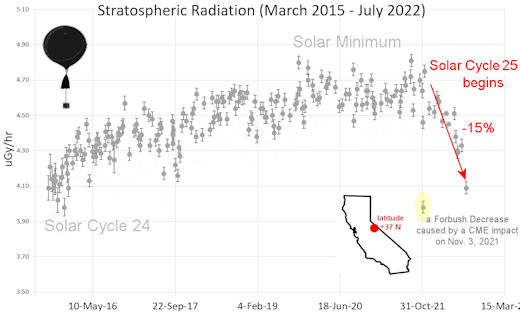
What's going on? Ironically, the radiation drop is caused by increasing solar activity. Solar Cycle 25 has roared to life faster than forecasters expected. The sun's strengthening and increasingly tangled magnetic field repels cosmic rays from deep space. In addition, solar coronal mass ejections (CMEs) sweep aside cosmic rays, causing sharp reductions called "Forbush Decreases." The two effects blend together to bring daily radiation levels down.
.Who cares? Cosmic rays are a surprisingly "down to Earth" form of space weather. They can alter the chemistry of the atmosphere, trigger lightning, and penetrate commercial airplanes. According to a study from the Harvard T.H. Chan school of public health, crews of aircraft have higher rates of cancer than the general population. The researchers listed cosmic rays, irregular sleep habits, and chemical contaminants as leading risk factors. A number of controversial studies (#1, #2, #3, #4) go even further, linking cosmic rays with cardiac arrhythmias and sudden cardiac death.
Technical notes: The radiation sensors onboard our helium balloons detect X-rays and gamma-rays in the energy range 10 keV to 20 MeV. These energies span the range of medical X-ray machines and airport security scanners.
Data points in the graph labeled "Stratospheric Radiation" correspond to the peak of the Regener-Pfotzer maximum, which lies about 67,000 feet above central California. When cosmic rays crash into Earth's atmosphere, they produce a spray of secondary particles that is most intense at the entrance to the stratosphere. Physicists Eric Regener and Georg Pfotzer discovered the maximum using balloons in the 1930s and it is what we are measuring today.
| | The official U.S. government space weather bureau |
| | The first place to look for information about sundogs, pillars, rainbows and related phenomena. |
| | Researchers call it a "Hubble for the sun." SDO is the most advanced solar observatory ever. |
| | 3D views of the sun from NASA's Solar and Terrestrial Relations Observatory |
| | Realtime and archival images of the Sun from SOHO. |
| | information about sunspots based on the latest NOAA/USAF Active Region Summary |
| | current counts of failed and deployed Starlink satellites from Jonathan's Space Page |
| | Authoritative predictions of space junk and satellite re-entries |
| | from the NOAA Space Environment Center |
| | fun to read, but should be taken with a grain of salt! Forecasts looking ahead more than a few days are often wrong. |
| | from the NOAA Space Environment Center |
| | the underlying science of space weather |
 | BestCSGOGambling is the best site for everything related to CSGO gambling on the web |
 | To find reviews of new online casino sites in the UK try The Casino DB where there are hundreds of online casino reviews complete with bonuses and ratings. Alternatively, Online-Casinos.xyz is another massive directory of online casinos listing sites for the UK and Worldwide. Casinos that offer Rupees for bonuses are very generous to Indian players. Find the best online casinos in India at AllCasinos.in Looking for a new online casino? Try Casimpo the new site dedicated to making online casino simple, or check out the new Avenger Slots Casino and Ace Online Casino with over 500 online slots and casino games. |
 | One of the most popular casino games is the Book Of Dead Slot based on ancient Egyptian text, you can find all the casinos with spins at bookofdeadslotsites.com. |
 | When looking for casinos to play online when the weather is bad, you can try casino online trucchi for Italian games. If you are not from Finland you can try the Swedish page Svenska casino online to find suitable games, check out svenskacasinoonline.net. Always check your local laws before playing with real money. |
 | Looking for sports betting companies not registered on GamStop? CasinoGap has presented a list of sites not on GamStop available for UK players. Check and bet online! Would you like to bet at sites not using GamStop? Look at a list of NonStopCasino sites for online betting that aren't on GamStop. Top-rated bookmakers ever! |
| | These links help Spaceweather.com stay online. Thank you to our supporters! |
| | | | | | |

